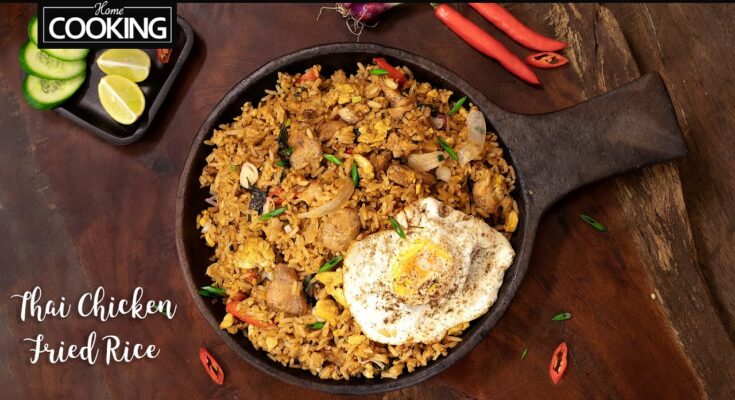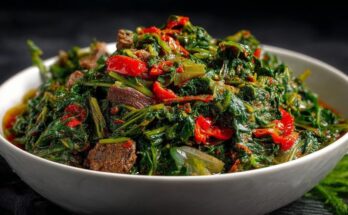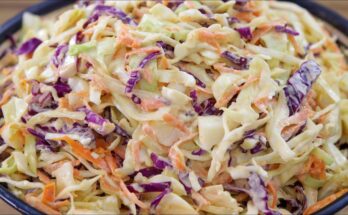Thai Fried Rice Recipe: There’s something about Thai fried rice that hits different. Maybe it’s the fragrance of jasmine rice sizzling in a hot wok, or the savory mix of sauces, proteins, and vegetables that dance together in harmony. Either way, it’s comfort food with a twist of exotic flair that everyone can enjoy—whether you’re new to Thai cuisine or a seasoned foodie.
What Makes Thai Fried Rice Unique?
Unlike your typical Chinese fried rice, Thai fried rice (Khao Pad) is made with jasmine rice. This fragrant long-grain variety gives the dish a light, slightly floral aroma that sets it apart. It’s often seasoned with fish sauce, oyster sauce, soy sauce, and a pinch of sugar, giving it that distinct umami depth.
What really stands out is how versatile this dish is. You can toss in chicken, shrimp, beef, tofu—whatever suits your taste buds. And it’s quick, too. In just about 15-20 minutes, you’ve got a meal that’s packed with flavor and texture.
History and Cultural Influence
Thai fried rice isn’t just food—it’s part of Thailand’s culinary identity. With Chinese influence embedded deep in its cooking style, Khao Pad was adapted to local tastes over time. Unlike stir-fried noodles or spicy curries, fried rice became the go-to “fast food” for busy Thai families. You’ll find it everywhere from roadside stalls to high-end restaurants.
In Thai homes, it’s a way to use up leftovers, a dish made on the fly with whatever’s in the fridge. That’s why no two plates of Thai fried rice are ever exactly the same—and that’s part of the charm.
Key Ingredients You’ll Need
Essential Ingredients List
Before we fire up the wok, let’s get our ingredients in order. Here’s what you’ll typically need for a basic Thai fried rice:
- 2 cups cooked jasmine rice (preferably day-old)
- 2 eggs
- 1 cup protein (chicken, shrimp, tofu, or pork)
- 2 cloves garlic, minced
- ½ cup diced onions
- ½ cup chopped tomatoes
- 2 tbsp soy sauce
- 1 tbsp fish sauce
- 1 tsp oyster sauce
- ½ tsp sugar
- 2 tbsp cooking oil
- Green onions and cilantro (for garnish)
- Lime wedges and cucumber slices (optional)
These ingredients are just the starting point. What you add next is up to your personal taste.
Tips on Choosing the Best Rice
Let’s talk rice, because it makes or breaks your dish. Thai fried rice calls for jasmine rice, and the key here is using rice that’s been cooked and cooled—preferably overnight in the fridge. This keeps it from turning into mush when stir-fried.
Freshly cooked rice is too soft and moist, which clumps up in the wok. If you’re in a rush, you can spread the rice out on a tray and pop it in the freezer for about 20 minutes to dry it out a bit. Just don’t skip this step. Dry, fluffy rice gives you that signature texture.
Preparing Ingredients Before Cooking
Chopping and Prepping Vegetables
This step is all about mise en place—getting everything ready before the heat hits. Dice your onions, chop the tomatoes, slice green onions, and mince the garlic. If you’re adding carrots, bell peppers, or peas, get those ready too. Uniform cuts help everything cook evenly, and trust me, in a fast-paced stir-fry, seconds matter.
Fresh veggies not only add crunch but color. They brighten the dish and give you that satisfying bite with every spoonful. If you’re using frozen veggies, make sure to thaw and pat them dry before tossing them into the wok to avoid sogginess.
Marinating and Preparing Protein
Whether you’re using shrimp, chicken, pork, or tofu, a quick marinade helps infuse flavor. Mix your protein with a bit of soy sauce, garlic, and a pinch of sugar. Let it sit while you prep the rest.
For tofu, press out excess water before frying to help it crisp up. For shrimp or chicken, cut into bite-sized pieces for even cooking. A little prep here goes a long way in making every bite burst with flavor.
Step-by-Step Cooking Instructions
Step 1 – Heat the Wok
Get your wok or large skillet screaming hot. Add oil and swirl it around. A hot pan is essential—it sears the ingredients instantly, locking in flavor and preventing sogginess.
Once the oil shimmers, you’re ready for the next step.
Step 2 – Cook the Eggs
Crack the eggs directly into the hot wok. Scramble them quickly and cook until just set. Push them to the side of the pan or remove and set aside. This keeps the eggs fluffy and prevents overcooking.
Step 3 – Add Garlic and Protein
Toss in the minced garlic and stir until fragrant (about 20 seconds). Add your marinated protein and cook through. For shrimp, cook until pink; for chicken or pork, ensure it’s no longer pink inside.
Step 4 – Mix in the Rice and Sauce
Once your protein is cooked, it’s time for the star of the show: the rice. Add your cold, day-old jasmine rice into the wok. Use a spatula to gently break up any clumps. Stir-fry it for about 2 minutes so it gets hot and starts to soak up all the flavors in the pan.
Now, it’s sauce time. Mix together your soy sauce, fish sauce, oyster sauce, and a pinch of sugar in a small bowl beforehand, and pour it evenly over the rice. Stir everything thoroughly so every grain gets coated in that rich, savory sauce. The rice should start to change color, taking on a beautiful golden-brown hue.
If you pushed the eggs aside earlier, now’s the time to mix them back in. Everything should be sizzling and smelling amazing at this point!
Step 5 – Toss in Vegetables and Final Touches
Next up, add your veggies—onions, tomatoes, carrots, peas, bell peppers, or whatever you’ve got prepped. Stir-fry for another 2–3 minutes until the vegetables are just tender but still crisp. You don’t want them to get soggy, so keep the heat high and stir frequently.
Finish off with chopped green onions, a handful of cilantro, and a quick squeeze of lime juice for that signature Thai tang. Want a bit of heat? Toss in a few slices of Thai chili or a dash of chili sauce.
Turn off the heat and give it one last toss. Boom—your Thai fried rice is ready to serve!
Variations of Thai Fried Rice
Thai fried rice is endlessly customizable. Here are a few delicious versions you can try based on your preferences or what’s in your fridge.
Chicken Thai Fried Rice
This one’s a classic. Thinly slice chicken breast or thighs, marinate in a bit of soy sauce and garlic, and follow the steps we just outlined. Chicken adds a savory depth that pairs perfectly with the sweetness of the sauce and crunch of veggies.
Pro tip: Use boneless thighs for juicier results.
Shrimp Thai Fried Rice
Shrimp cooks super fast, making it perfect for a weeknight meal. Just clean and devein your shrimp, then marinate briefly in garlic and fish sauce. Cook them until they turn pink, and you’re good to go. Add a few pineapple chunks if you want a sweet and tangy twist!
Shrimp also pairs well with chili paste if you like a bit of kick.
Vegetarian Thai Fried Rice
Going meatless? No problem. Swap the protein for tofu or more veggies. Add mushrooms, baby corn, and snap peas for a medley of flavors and textures. You can even scramble some tofu in place of the eggs if you want a vegan option.
Use soy sauce and a dash of hoisin instead of fish sauce for a fully plant-based dish.
Tips for Perfect Thai Fried Rice Every Time
Do’s and Don’ts
Let’s break down some do’s and don’ts to make sure your fried rice comes out restaurant-quality every time.
Do:
- Use day-old rice.
- Pre-mix your sauce before cooking.
- Keep your ingredients prepped and ready.
- Use high heat and a large pan or wok.
- Add ingredients in stages, not all at once.
Don’t:
- Use freshly cooked rice (too wet!).
- Overcrowd the pan.
- Overcook the vegetables.
- Skip the garnishes—they matter!
Common Mistakes to Avoid
One major mistake people make is cooking everything at once. Thai fried rice is a fast-moving dish—you need to work in layers. Another common error? Not using enough heat. A hot pan is crucial for that smoky, “wok hei” flavor.
Also, don’t drown your rice in sauce. Too much sauce makes it soggy. You want just enough to coat the grains without overwhelming the dish.
Serving Suggestions
Best Side Dishes
Thai fried rice is a complete meal on its own, but pairing it with the right sides can elevate the entire experience. Here are some classic Thai sides that go perfectly with your savory rice:
- Thai Spring Rolls – Crispy, golden, and filled with veggies or shrimp, they add crunch and contrast.
- Tom Yum Soup – A spicy, tangy soup that balances out the richness of the fried rice.
- Green Papaya Salad (Som Tum) – Refreshing and zesty, this salad adds a nice cold crunch.
- Satay Skewers – Chicken or beef skewers with a side of peanut sauce make for a tasty protein addition.
- Cucumber Salad – Light, slightly sweet, and super cooling—great if your fried rice is on the spicy side.
You can also serve Thai fried rice with a fried egg on top—commonly known in Thailand as “Khao Pad Kai Dao.” That runny yolk mixing with the rice? Absolute perfection.
Garnishing and Presentation Ideas
Don’t skip the garnish—it’s the finishing touch that takes your fried rice from good to gorgeous. Here’s how to plate like a pro:
- Sprinkle chopped green onions and fresh cilantro for color and aroma.
- Add lime wedges on the side—squeezing lime juice right before eating brightens everything up.
- Thinly sliced cucumber or tomato on the edge of the plate adds a refreshing bite.
- For some crunch, top with fried shallots or crushed peanuts.
- Want it Instagram-worthy? Serve it in a hollowed-out pineapple for a true Thai restaurant vibe.
Presentation makes a difference, especially when you’re serving guests or sharing food pics online. A beautiful plate invites you to dig in with all your senses.
Storing and Reheating Leftovers
How to Store Properly
If you’ve made a big batch, don’t worry—Thai fried rice stores well. Just follow these tips:
- Let the fried rice cool completely before storing. Hot rice trapped in a container can become soggy.
- Use an airtight container to prevent it from drying out or absorbing fridge odors.
- Store in the refrigerator for up to 3 days.
Avoid freezing, as the rice texture can change dramatically after thawing.
Best Reheating Methods
When reheating, you want to bring back that original flavor and texture—not end up with soggy, bland rice. Here are your best bets:
- Stovetop (Best Option)
- Add a small splash of water or oil to a hot skillet or wok.
- Stir-fry the rice over medium heat for 3–5 minutes until it’s heated through.
- Microwave (Quickest Option)
- Place the rice in a microwave-safe bowl.
- Cover it with a damp paper towel to retain moisture.
- Heat in 30-second intervals, stirring in between.
Avoid reheating multiple times—only warm up what you plan to eat in one sitting. That keeps the flavor and safety in check.
Nutritional Value and Health Insights
Calories and Macronutrients
Wondering how Thai fried rice stacks up nutritionally? Here’s a general breakdown per serving (about 1.5 cups):
| Nutrient | Amount |
|---|---|
| Calories | 400–500 kcal |
| Protein | 15–25g (depending on the protein source) |
| Carbohydrates | 45–55g |
| Fat | 10–15g |
| Fiber | 3–5g |
The numbers vary based on your ingredients and portion size. If you’re using more veggies and lean protein, it’ll be on the healthier side.
Making It Healthier
Want to enjoy your Thai fried rice guilt-free? Here’s how to lighten it up without losing flavor:
- Use brown jasmine rice for added fiber and nutrients.
- Cut back on the oil—a little goes a long way.
- Skip or reduce the fish sauce to lower sodium.
- Load up on veggies to increase vitamins and volume.
- Use lean proteins like chicken breast or tofu.
- Opt for low-sodium soy sauce for a heart-healthier option.
Making smart swaps lets you enjoy this dish more often while keeping it balanced and nutritious.
FAQs about Thai Fried Rice Recipe
Can I use freshly cooked rice?
Fresh rice is too moist for fried rice. Always use day-old, chilled rice for the best texture.
What’s the best oil for Thai fried rice?
Neutral oils like canola, vegetable, or peanut oil work best. They handle high heat without overpowering the dish.
How spicy should Thai fried rice be?
Totally up to you! Traditional versions aren’t super spicy, but you can add Thai chilies or chili paste if you like heat.
Can I make it gluten-free?
Yes—just swap soy sauce and oyster sauce for gluten-free versions, and skip the fish sauce or use a GF alternative.
Is Thai fried rice the same as Chinese fried rice?
Nope! Thai fried rice uses jasmine rice and different seasoning sauces, giving it a distinct flavor compared to Chinese fried rice.
Conclusion
Thai fried rice is more than just a meal—it’s an experience. From its fragrant jasmine rice base to its vibrant mix of sauces and toppings, every bite tells a story of flavor, tradition, and creativity. Whether you’re cooking up a quick dinner or impressing guests at your next gathering, this dish never fails to deliver.
With this step-by-step guide, you’re fully equipped to whip up restaurant-quality Thai fried rice at home. Remember, the key lies in good prep, a hot wok, and that perfect sauce combo. Play around with variations, customize the heat level, and don’t forget the garnishes.
Happy cooking—and don’t be surprised if this becomes your new go-to meal!



